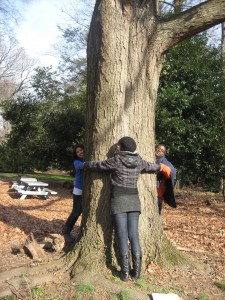Letterboxing

Originally appears in the Summer 2012 issue
In its simplest form, letterboxing is an outdoor treasure hunt for a hidden box. Seekers of the box carry their own personal stamp, “passport book,” pencil/pen, and a set of clues that guide them to the box. Once the box is found, the stamp inside the box provides documentation of the discovery.
Letterboxing, much like geo-caching and orienteering, involves following a trail of clues. The difference is that the clues are descriptive and require a broad set of skills, beyond following coordinates using a compass or a GPS. Letterboxing techniques are used to engage students in the academic challenge of following or creating a trail of clues using identification skills, math, mapping tools, descriptive writing, and artistic design. By documenting the features of the landscape using these multidisciplinary skills, students have an adventure that promotes a sense of place. Whether placed in a schoolyard, a nature center, or a park (i.e. as long as notice is given and permission is received), letterboxes provide an opportunity to observe, measure, and wax poetic over any given landscape.
Letterboxing originated in the Dartmoor region of England in the 1854, when James Perrott placed a bottle with his calling card in a remote location along the banks of Cranmere Pool. He encouraged others to find his card and share theirs. In 1888, a small tin box replaced the original bottle and visitors left self-addressed postcards that could be taken and mailed back from their hometown. Calling cards were later replaced by rubber stamps and a log book. Letterboxing stayed a mostly Dartmoor tradition until 1998 when the U.S. magazine Smithsonian published a small article and the Internet allowed people to find clues to sites all over the world. Today, there are likely to be numerous letterboxes within a short distance of your school.[i]
To view the photo-rich magazine version, click here.
If you are not already a subscriber, please subscribe to read the full article
Vivian Williams is the Education Program Manager and Program Design Specialist for the Stroud Water Research Center in Avondale, Pennsylvania. She is also a guest naturalist for the Eagles Mere Conservancy, has her own environmental education consulting business, and offers workshops on letterboxing and another entitled “The Color of Water: Mixing Art and Science.”
Leave a Reply
You must be logged in to post a comment.





